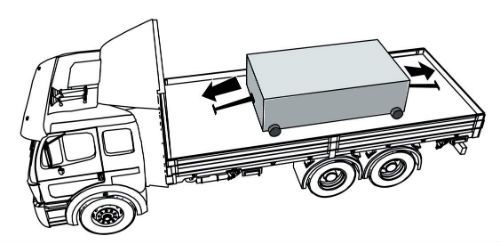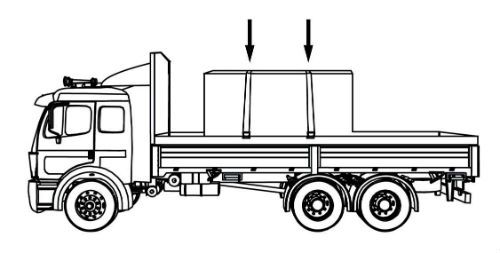CDL Practice Tests: Flatbed Cargo Securement
Choose A Section:
Go!In what circumstance can shortwood be treated as longwood?
- When it is stacked long-ways on the trailer.
- When it is painted green on the ends.
- When it is embedded in a stack of longwood.
- Right after it is cut down.
What's in a stack?

Some stacks may be made up of both shortwood and longwood. Any stack that includes shortwood must follow the shortwood securement requirements.
Exception: If shortwood is embedded in load of longwood, it can be treated as longwood.
When securing metal coils with eyes vertical, the angle between tiedown and deck, if possible, should be:
- 60 degrees
- Between 60 and 90 degrees
- Less than 45 degrees
- 180 degrees
- Attach at least one tiedown against front of row of coils to restrain against forward motion. If possible, angle between tiedown and deck should be less than 45, when viewed from the side of the vehicle.
- Attach at least one tiedown against rear of row of coils to restrain against rearward motion. If possible, angle between tiedown and deck should be less than 45, when viewed from the side of the vehicle.
- Attach at least one tiedown over top of each coil or side-by-side row of coils to restrain against vertical motion. Tiedowns going over top of coil(s) must be as close as possible to eye of coil.
- Arrange tiedowns, blocking, or bracing to prevent shifting or tipping in all directions.
A female housing fixed to the side or ends of a vehicle to receive a stake or peg, and may also be used as an anchor point is a:
- Cleat
- Void filler
- Bulkhead
- Stake pocket
Stake Pocket:
A female housing fixed to the side or ends of a vehicle to receive a stake or peg, and may also be used as an anchor point.
As part of the log packing requirements:
- Logs must be loosely packed.
- Outer bottom logs must be in contact with and rest solidly against bunks, bolsters, stakes, or standards.
- The center of the highest log on each side or end must be above the top of each stake, bunk, or standard.
- Each inside log on the side of a stack of logs must touch at least two bunks, bolsters, stakes, or standards.
Packing requirements
- Logs must be solidly packed.
- Outer bottom logs must be in contact with and rest solidly against bunks, bolsters, stakes, or standards.
-
Each outside log on the side of a stack of logs must touch at least two bunks, bolsters, stakes, or standards. If one end of the log doesn't touch a stake:
- It must rest on other logs in a stable manner.
- It must extend beyond the stake, bunk, bolster, or standard.
- The center of the highest log on each side or end must be below the top of each stake, bunk, or standard.
What is the minimum number of tiedowns to use on a load 4ft 7in long, and weighing 1,237 lbs?
- 4
- 2
- 1
- 3
-
If load is 5ft or shorter, 1,100 lbs or lighter:
Minimum number of tiedowns: 1
-
If load is 5ft or shorter, over 1,100 lbs:
Minimum number of tiedowns: 2
-
If load is more than 5ft but less than 10ft:
Minimum number of tiedowns: 2
Methods of securing building materials against forward motion include:
- These are all valid methods.
- Employing blocking equipment.
- Using tiedowns.
- Placing bundles against the bulkhead or front end.

-
Option #1
Place bundles against bulkhead/front end structure.
-
Option #2
When different tiers need to be secured, use a combination of blocking equipment and tiedowns.
What is the minimum requirement for securing roll-off and hook containers?
- Two tiedowns installed lengthwise, each securing one side of the container to one of the vehicle's side rails.
- Two hooks, or an equivalent mechanism, securing both sides of the container to the vehicle chassis.
- All of these are acceptable.
- One tiedown attached to both the vehicle chassis and the container chassis.
Secure to the rear of the vehicle with at least one of the following three mechanisms:
-
Rear Mechanism 1:
One tiedown attached to both the vehicle chassis and the container chassis.
-
Rear Mechanism 2:
Two tiedowns installed lengthwise, each securing one side of the container to one of the vehicle's side rails.
-
Rear Mechanism 3:
Two hooks, or an equivalent mechanism, securing both sides of the container to the vehicle chassis at least as effectively as the tiedowns in the two previous items.
When securing metal coils, it is acceptable to use nailed blocking or cleats as the sole means to secure:
- Timbers
- Chocks
- It is not acceptable.
- Nailed wood cradles
The use of nailed blocking or cleats as the sole means to secure timbers, chocks or wedges, or a nailed wood cradle, is prohibited.
If the cargo is fully contained in a sided vehicle, what is the minimum requirement for withstanding sideways force?
- 0.8g (80% of cargo weight)
- 0.7g (70% of cargo weight)
- 0.2g (20% of cargo weight)
- 0.5g (50% of cargo weight)
Note: If the cargo is contained in a sided vehicle, the vehicle structure MUST be strong enough to withstand the forces described earlier.
- Forward force: 0.8 g (80%)
- Rearward force: 0.5.g (50%)
- Sideways force: 0.5 g (50%)
When securing paper rolls with friction mats as a primary method:
- All of these answers.
- The friction mat should stick out from underneath the roll in the direction it is providing securement.
- The friction mat should stick out from underneath the roll in the opposite direction for which it is providing securement.
- Make sure friction mats are completely covered by the roll.
Requirements for friction mats

If a friction mat is used to provide the principal securement for a paper roll, insert the friction mat so that it sticks out from beneath the footprint of the roll in the direction in which it is providing securement.
About The Flatbed Cargo Securement CDL Manual
Studying the flatbed cargo securement CDL manual is not a requirement for getting your CDL permit or license. It is required knowledge for flatbed drivers.
Some questions you should be able to answer for flatbed cargo securement:
- What is the minimum Working Load Limit of a tiedown used to secure logs?
- What is the minimum weight of a shipment of paper rolls that would require specific securement requirements?
- When securing concrete pipe over 45 inches loaded crosswise, which direction must the tiedowns on the front half of the load run?
- What is a cab shield?
- When securing concrete pipe over 45 inches loaded crosswise, which direction must the tiedowns on the rear half of the load run?
- What is a dunnage bag?
- Who is responsible for inspecting securing devices and cargo within the first 50 miles?
- How many tiedowns are required on a stack of shortwood loaded crosswise?
- What is the minimum working load limit of each tiedown used to secure crushed or flattened vehicles?
- Define 'bolster'
- What is a hook-lift container?
- When a tiedown is attached directly to the cargo, what is the ideal angle where it attached to the vehicle?
What is a securing device?
Any device specifically manufactured to attach or secure cargo to a vehicle or trailer:
- Synthetic Webbing
- Chain
- Wire rope
- Manila rope
- Synthetic rope
- Steel strapping
- Clamps and latches
- Blocking
- Front-end structure
- Grab hooks
- Binders
- Shackles
- Winches
- Stake pockets
- D-rings
- Webbing ratchet
- Bracing
- Friction mat
What is a tiedown?
A combination of securing devices that forms an assembly that:
- Attaches cargo to, or restrains cargo on a vehicle.
- Is attached to anchor point(s).

Some tiedowns are attached to the cargo and provide direct resistance to restrain the cargo from movement.

Some tie-downs pass over or through the cargo. They create a downward force that increases the effect of friction between the cargo and the deck. This friction restrains the cargo.
 Related Cargo Securement Terms That Every Driver Should Know:
Related Cargo Securement Terms That Every Driver Should Know:
-
Tiedown:
A combination of securing devices which form an assembly that attaches cargo to, or restrains cargo on, a vehicle or trailer, and is attached to anchor point(s).
-
Contained:
Cargo is contained if it fills a sided vehicle, and every article is in contact with or sufficiently close to a wall or other articles so that it cannot shift or tip if those other articles are also unable to shift or tip.
-
Blocking:
A structure, device, or another substantial article placed against or around an article to prevent horizontal movement of the article.
How should tiedowns be attached?
Tiedowns can be used in two ways:
-
Attached to the cargo:
- Tiedowns attached to the vehicle and attached to the cargo.
- Tiedowns attached to the vehicle, pass through or aroundan article of cargo, and then are attached to the vehicle again.
-
Pass over the cargo:
- Tiedowns attached to the vehicle, passed over the cargo, and then attached to the vehicle again.
Tiedown placement:

Place the tiedown as close as possible to the spacer.
Position the tiedowns as symetrically as possible over the length of the article.

Position the tiedowns to preserve the integrity of the article.







 TT On Facebook
TT On Facebook